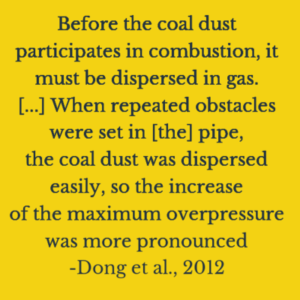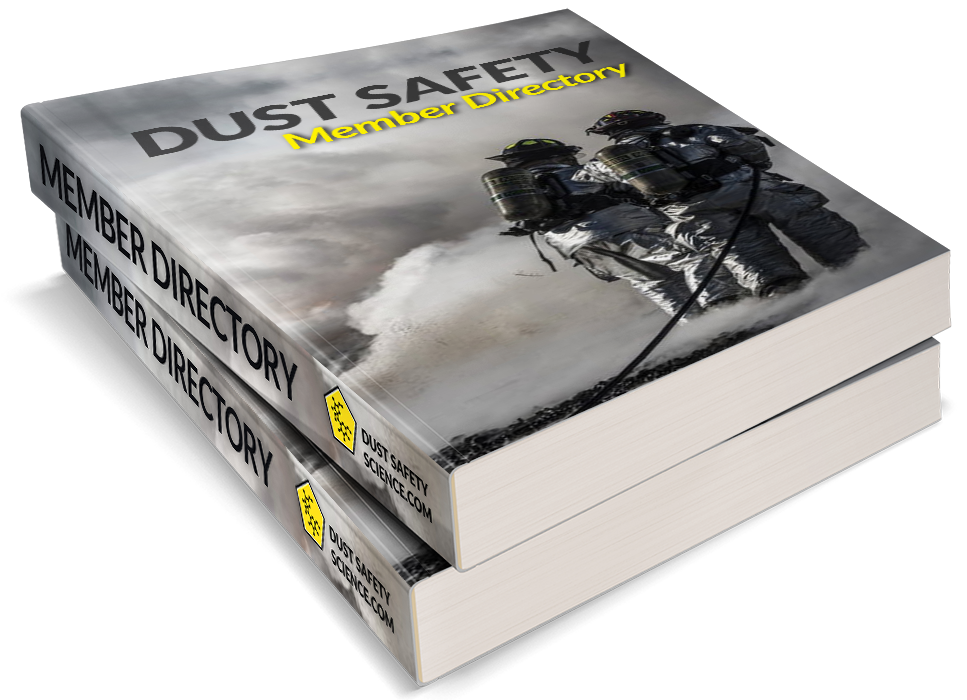1-Sentence-Summary: Flame propagation in a tube is greatly enhanced by obstacles in the flow path and coal deposits if they can be entrained into the air.
Authors: C. Dong, M. Bi, and Y. Zhou
Read in: Three Minutes
Favourite quote from the paper:

The authors perform experimental explosion tests in a horizontal pipe closed at both ends. The pipe has an inner diameter of 10 cm and is 2.4 m in length. The explosive mixture is ignited at one end of the tube using a spark plug.
Flame propagation in methane gas of various concentrations is explored. A single obstacle is placed in the pipe and the impact of location on flame acceleration is explored. Next, an increasing number of obstacles placed at even spacing is investigated. Lastly, the effect of coal deposits on methane flame speed is investigated with and without obstacles in the pipe. In all cases the obstacles have a blockage ratio of 50% of the pipe area.
Three of the main findings from this paper are:
- Flame propagation in the pipe without obstacles consists of four stages: a constant pressure stage, an acceleration stage, a quasi-steady flame propagation, and lastly, the maximum pressure stage.
- The location and density of obstacles in the pipe greatly effects flame propagation.
- Coal dust deposits require obstacles in the pipe to enhance the methane explosion.
The following sections outline the main findings in more detail. The interested reader is encouraged to view the complete article at the link provided below.
Finding #1: Flame propagation without obstacles consists of four stages
The authors demonstrate that flame propagation in the pipe consists of four stages. In the first stage the flame has not reached the pipe walls and the pressure is almost constant. In the second stage, the flame interacts with the walls and goes through a transient period of acceleration while the flame shape changes.
Once a steady flame shape is obtained a period of quasi-steady propagation down the tube is shown. This third stage lasts for the majority of the explosion. In the final stage the maximum pressure is reached as the flame approaches the end of the tube. This is followed by heat loss to the vessel walls and a decrease in pressure. In the final stage, acoustic oscillations are seen as the methane concentration approached stoichiometric. Fuel lean conditions tend to show less acoustic pressure oscillations.
Finding #2: Obstacle location and spacing greatly alters flame propagation
The authors perform tests with a single obstacle placed at different positions in the pipe, and with multiple obstacles evenly spaced. When a single obstacle is placed in the first half of the pipe, a quadratic relationship between the obstacle location and flame propagation rate is found. For 6% methane gas, the fastest explosion occurs when the obstacle is placed closest to the ignition end of the pipe. For 9.5% methane gas, the fastest explosion occurs when the obstacle is placed at the quarter length distance down the pipe. When the obstacle is placed in the second half of the pipe, the rate of explosion decreases in a linear manor with obstacle distance down the pipe.
The maximum explosion pressure and maximum rate of pressure rise increase dramatically as the number of obstacles in the pipe increase. For example, at 9.5% methane the maximum pressure increases from 0.4 to 0.8 MPa when seven obstacles are added. The increase in explosion rate is not quantified, but the pressure time traces demonstrate a drastically increased explosion rate when many obstacles are present.
Finding #3: Coal deposits enhance the methane explosion only when obstacles are present
A continuous coal dust deposit at the bottom of the pipe has little impact on methane flame propagation and even reduces the maximum pressure in some cases due to heat loss. However, the coal dust deposit could increase maximum pressure when obstacles are present. In general, two to three obstacles are required before the hybrid explosion has larger maximum pressure maximum pressure is increased by 5-10% from coal deposits in the pipe.
My Personal Take-Aways From
“Effects of Obstacles and Deposited Coal Dust on Characteristics of Premixed Methane-Air Explosions in a Long Closed Pipe”
This paper is useful for anyone studying flame propagation in underground coal mines. In addition to presenting interesting experimental results, it gives a good overview of research papers studying the effect of obstacles on flame propagation in long-narrow channels.
The finding that coal dust deposits require obstacles to become entertained in air is interesting. This suggests that under similar conditions, explosions of coal dusts alone may have similar requirements. It is important to note that dust lifting by blast and shock waves (different than the premixed deflagration case studied here) has been shown to be capable of entraining dust elsewhere in the literature (e.g., Gosteev and Fedorov, 2002, Zydak, 2007, and Houim and Oran, 2015).
Full Citation: [bibtex file=references.bib key=Dong2012]
[otw_shortcode_button href=”https://www.sciencedirect.com/science/article/pii/S0925753512000896″ size=”medium” icon_position=”left” shape=”square”]> > Get The Article[/otw_shortcode_button]
